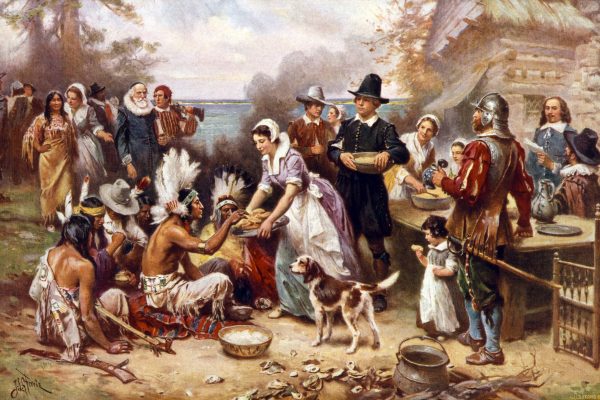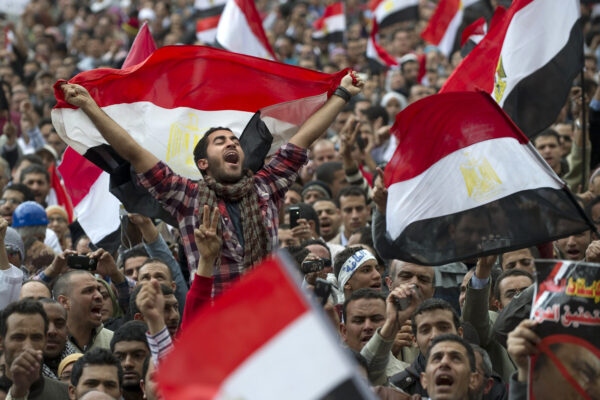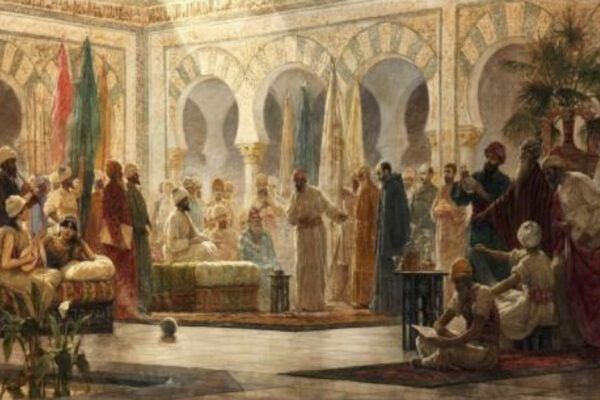While the statesmen of the Islamic Republic never openly adhered to nationalism in the early years after the revolution, they still continued many of the nationalist policies inherited from the Pahlavi dynasty. This includes the Persian-only education system as well as compulsory national military service. This also includes Iran’s nationalist narrative: the school curriculum for history education continued largely on the same line as before, focused on a continuous Iranian identity throughout history.
Crafting ‘Art of Persia’: Debates on National and Religious Identity in Contemporary Iran
While the statesmen of the Islamic Republic never openly adhered to nationalism in the early years after the revolution, they still continued many of the nationalist policies inherited from the Pahlavi dynasty. This includes the Persian-only education system as well as compulsory national military service. This also includes Iran’s nationalist narrative: the school curriculum for history education continued largely on the same line as before, focused on a continuous Iranian identity throughout history.
This article was originally written for Ajam Media Collective by author Kaveh Abbasian. You can find the original article here.
In the summer of 2020, BBC Four aired a documentary series entitled Art of Persia. The series described 3,000 years of history and provided its audience with a narrative of Iran and Iranian identity that is common and familiar in which the “nation of Iran” and “Iranian identity” are natural, homogenous, and continuous elements throughout history. Persian ethnicity is at the narrative’s core and the Persian language is presented as the savior of Iranian identity in the face of hardships such as the “Arab invasion”.
This way of telling Iran’s history is heavily inspired by a nationalist narrative first officialised during the Pahlavi dynasty and which can be traced back to the efforts of the late nineteenth century modernist intellectuals in Iran, a narrative which downplays Iran’s diversity in favor of a homogenous and monolithic national identity.
The series conforms to this narrative from several angles. For instance, it anachronistically assigns modern concepts such as “national identity” to the ancient past. It frequently conflates the terms “Persian” and “Iranian” to such an extent that the viewer might assume all Iranians are Persians, even though only 50% of Iran’s population speak Persian as their first language.
The series even presents outright false information, such as when it claims that Nowruz is a “unique Persian new year” – even though many other peoples from central to west Asia celebrate Nowruz. It also claims that after the Arab conquest, Persians were the only people in the Middle East to “preserve” their language and identity. This is false: many other languages in the region, including Kurdish, Gilaki, Mazandarani, Laki, Baluchi, and Assyrian, went through a similar process. The rise of Arabic didn’t mean that these languages died out; many not only survived but were transformed through their interaction with Arabic, just as other cultures influenced them both before and after.
The nationalist narrative of Iran’s history espoused by the series is broadly based on the idea of a “pure Persian culture” perpetually in conflict with “Arab Islam,” one which is common in contemporary politics. This narrative often argues that the 1979 Revolution brought this Islam into political power, suppressing Iranian nationalism in favor of a pan-Islamic identity focused only on the umma (international Islamic community).
Although the series does not focus on the politics of the Islamic Republic, the framing of the documentary seems intended to lead its audience to conclude that “pure Persian” culture and “Iranian identity” will survive yet another “invasion”. This narrative defines the Islamic Republic’s national identity-building project in opposition to that of the Pahlavi dynasty, framing one as Islamic against an Aryan/Iranian counterpart.
A careful study of the matter shows that these two projects are not in opposition to each other. The Islamic Republic’s conceptualization of national identity is in many ways a logical continuation of what the Pahlavi dynasty began before them. Both the Islamic Republic and supporters of the Pahlavi dynasty have framed their ideological projects as diametrically opposed. An examination of how national identity has been framed since 1979 reveals far more in common than either care to admit, disturbing the binary division of Islamic versus Iranian identity that is at the core of so many contemporary debates about Iran.
Reza Shah, who established the Pahlavi dynasty in 1925, built his nation-state building project on the celebration and glorification of an imagined utopian and purely Aryan past. This was an ideology championed both by Western intellectuals active in Iran as well as local modernist and nationalist thinkers. As part of the promotion of this Aryan ideology, translation and production of nationalistic scholarly works were encouraged, and historians were employed to study and craft the history of Iran.
German archaeologist Ernst Herzfeld’s ideas of Achaemenid Iran as a geopolitical concept and as “the empire of Aryans,” together with his idea that the “Iranian nation” emerged during the Achaemenid period, were in particular adopted as the official ideology of the dynasty’s national identity project. This Aryan ideology was followed by the second Pahlavi king, Mohammad Reza Shah, and became one of the most recognisable characteristics of the Pahlavi era, despite the fact that it was largely disproven as historical fact.
As part of his modernization program, Reza Shah clashed with certain aspects of the Islamic doctrine in Iran. For instance, he restricted Shi’i mourning observances, banned the chador, and for a time legally required women to appear in public without head coverings. However, contrary to popular belief that often frames Reza Shah as anti-Islam, he was not anti-Islam per se, but could be seen as trying to shape what Islam would look like in Iran. Most of such restrictions proved to be unpopular and were later reversed.
Likewise, his son, Mohammad Reza Shah could hardly be considered anti-Islam, having promoted the role of Islam in society, publicly going on Muslim pilgrimages, and patronizing Islamic rituals. He also had close ties with the clergy, evident in the events surrounding the premiership of Mohammad Mosaddegh and the 1953 coup during which major clerics appeared in full support of the young monarch.
During his reign, Islamic debates were systematically supported and boosted to combat the increasing influence of revolutionary Marxist ideas, which he considered a greater threat to his power. For example, the cleric Morteza Motahhari who wrote and lectured against Marxism, was made a member of the Imperial Iranian Academy of Philosophy and was given the Royal Book of the Year Award and a lecturer position at Tehran University. In his book, “Both Eastern and Western: An Intellectual History of Iranian Modernity”, Afshin Matin-Asgari shows how the royal court accommodated not only the clergy’s anti-Marxist campaigns but also the efforts of several Islamic intellectual circles aiming to construct an “authentic native Iranian culture” based on Shi’i Islam and a radical critique of “the West”. Ahmad Fardid, Henri Corbin, Jalal Al-Ahmad, Dariush Shayegan, Morteza Motahhari, and Seyyed Hossein Nasr were among influential figures active in these circles.
Out of these figures, Seyyed Hossein Nasr, a major traditionalist and an Islamic philosopher, was the most symbolic of this connection; he was appointed personal secretary to Farah Pahlavi, the Shahbanu (Empress) of Iran, as head of her private bureau. He was tasked with establishing and leading the Imperial Iranian Academy of Philosophy based on the principles of philosophical traditionalism. While Nasr was in direct contact with the royal court, Motahhari was in constant and direct contact with Khomeini who at that time lived in exile in Najaf, Iraq.
The ideas that were pushed forward by these circles played an important role in the development of the ideology of the Islamic Republic. It can be argued that the beginnings of the Islamic Republic’s version of Iranian nationalism, with a focus on authentic native Islamic culture, was already being pushed forward before the revolution by the royal court.
While the statesmen of the Islamic Republic never openly adhered to nationalism in the early years after the revolution, they still continued many of the nationalist policies inherited from the Pahlavi dynasty. This includes the Persian-only education system as well as compulsory national military service. This also includes Iran’s nationalist narrative: the school curriculum for history education continued largely on the same line as before, focused on a continuous Iranian identity throughout history.
In his essay, “Islamic-Iranian Nationalism and its Implications for the Study of Political Islam and Religious Nationalism”, Kamran Scot Aghaei argues that under the Islamic Republic “the primordialist Iranian nation has generally been accepted as real, and its past glories have commonly been praised, including Iran’s pre-Islamic heritage”. The Islamic Republic’s nation-state building project was not based on a purely Islamic identity but incorporated strong elements from the Pahlavi project. This led to a form of Islamic Iranian exceptionalism.
While references to the “Aryan race” did not appear in the official language of the new regime, neither did they systematically oppose Aryan ideology. On the other hand, what they did focus on was the Shi’i Islamic aspect of the Iranian identity which had been an important component of the empire-building campaigns of several ruling elites in Iran’s history, such as the Safavids. In practice, that resulted in limitations being put on minority religious communities such as Zoroastrians.
Due to the significance of Zoroastrianism in the Pahlavi nationalist narrative, some observers took these steps as anti-Iranian or anti-nationalist policy, not taking into account the fact that other religious minorities such as Baha’is or Sufi communities fell victim to even harsher oppressive measures.
Islamic Iranian exceptionalism, or even more accurately Shi’i Iranian exceptionalism, is evident in the Iranian war propaganda during the Iran-Iraq War (1980-1988), which immediately followed the 1979 Revolution. In documentaries aired on state television, Iranian fighters were depicted as heralds of a new Islamic world for whom the planet had been waiting for centuries.
Morteza Avini, the director of the iconic war documentary series Chronicle of Triumph (1986-1988), was central in creating the propaganda language of the Islamic Republic. In an interview for Film magazine, he consciously merged his Shi’ism with a sense of Iranian exceptionalism, claiming: “Iran is the source of the whole of Islamic culture, even Islamic mysticism. Even jurisprudential and scholarly debates on religious thought in Islam come from Iran and Iranian thinking. The relationship that we Iranians created with Islam was better than the relationship that the Arabs created”.
This form of Shi’i Iranian exceptionalism has become one of the most noticeable aspects of the Islamic Republic’s rule in the last two decades, especially during the presidency of Mahmoud Ahmadinejad (2005-2013). Ahmedinejad and his team insisted on an Iranian interpretation of Islam and what they called “Iranian Islam” or the “Iranian school” (maktab-e Irani). While this approach met backlash from certain clerical circles who argued that it undermined the unity of Islam, it proved popular and had a long-lasting effect.
Ahmadinejad and his team managed to temporarily bring the Cyrus Cylinder, one of the most iconic symbols of Iranian Aryan national ideology, back to Iran from Britain to exhibit it with much fanfare for an enthusiastic public.
The Pahlavi propaganda machine’s narrative regarding this cylinder distorted its content to bolster its own credibility and combat accusations of human rights violations. Ahmadinejad in turn called the Cylinder the first-ever charter of human rights and declared that “today the world desperately needs the culture and the wisdom of the Iranian nation”. In a symbolic move during the unveiling ceremony of the Cylinder, Ahmadinejad put an Iranian keffiyeh scarf (the type worn by Iran’s Islamic militia, Basij) around the necks of two actors representing Cyrus the Great and Kaveh the Blacksmith (a pre-Islamic mythological figure).
In her book Iran Reframed, Narges Bajoghli argues that after seeing widespread youth support for the 2009 Green Movement, ideologues and cultural producers of the Islamic Republic began seriously considering reshaping the government’s image by including explicitly Iranian nationalistic elements in cultural productions. These cultural producers aimed to make their propaganda more attractive for the younger generation who didn’t live through the revolution and the war and weren’t necessarily interested in the exclusively Islamic narrative of their history. Bajoghli notes how in the narrative presented at Tehran’s Sacred Defence Garden and Museum, a megacomplex established in 2010 dedicated to the Iran-Iraq War’s history, “the war is recast as a nationalist project … rather than a religious quest.”
Since Ahmadinejad’s term ended in 2013, this official approach towards Iran’s pre-Islamic history entered even more aspects of state cultural activities, from urban murals to film productions. It is no longer surprising to see illustrations of pre-Islamic mythological figures such as Arash the Archer (said to have set the boundary of Iran with the throw of an arrow) next to the ones of mullahs or revolutionary guards. Likewise, it is common to see young men beating their chests during the month of Muharram for Imam Hussein while wearing Farvahar necklaces, a pre-Islamic and Zoroastrian symbol, previously promoted by the monarchy as a national symbol. These recent developments in the official strategy of the state and cultural behaviour of the masses are part of a continuing interplay between nationalist and Islamic tendencies in contemporary Iran.
This new trend has proved useful in justifying Iran’s involvement in recent wars in the region. By presenting Iranian fighters abroad as defenders of Iran as well as “holy shrine defenders” (against the desecration of Shi’i shrines in Syria and Iraq), they attracted the attention of different sections of the country’s population, from devout Muslims to ardent nationalists. They inspired public support for figures such as Qasem Soleimani, who was seen as a unifying figure who could bring those various and at times opposing sections of Iranian society together. A rather interesting and politically significant call of support came from a number of monarchists in exile. In recent years, some monarchists developed a soft spot for the Islamic Republic; something previously unimaginable.
For instance, Omid Dana, a monarchist activist in Sweden, has repeatedly compared Ali Khamenei, Iran’s supreme leader, to Darius the Great, the pre-Islamic Achaemenid king. He mourned the killing of Soleimani and likened him and the fighters under his command to an Achaemenid military unit known as the Immortals (Gard-e Javidan). The most surprising moment came when Ardeshir Zahedi, Iran’s pre-revolution high-ranking diplomat and an avid monarchist, living in Switzerland, declared in an interview with BBC Persian that Soleimani was a son of Iran and an honourable and patriotic soldier.
What at first might seem contradictory – monarchist exiles supporting the Islamic Republic – makes sense considering both the role of Islam in Pahlavi Iranian nationalism and the Islamic Republic’s nationalist policies since 1979. Both the monarchists and the Islamic Republic have stressed their differences from each other, an argument that seemed to have influenced the BBC documentary as well. However, this article shows how they are in fact similar in many ways and how, perhaps surprisingly, the Islamic Republic has adopted and continued many Pahlavi policies rooted in nationalism.
These examples show not only that the Islamic Republic is deeply rooted in Iran, but also that through the state’s incorporation of aspects of the Aryan national ideology in their nation-building project, they have strengthened a sense of Shi’i-Iranian nationalism and continue to use it in order to garner public support and gain political legitimacy.
Bibliography
Aghaie, K.S. (2014). Islamic-Iranian Nationalism and its Implications for the Study of Political Islam and Religious Nationalism. Rethinking Iranian Nationalism and Modernity. ed. Aghaie, K.S. and Marashi, A. University of Texas Press. USA.
Avini, M. (1992). Sinama, Teknolozhy va Sakhtar-e Hoviyati Bara-ye Ensan-e No (Cinema, Technology, and Identity Structure for the New Man). Film Magazine (123). In Avini, M. (2015). Ayene-ye Jadoo (Magic Mirror). Volume III. Vaahe. Tehran. pp.119-180.
Bajoghli, N. (2019). Iran Reframed: Anxieties of Power in the Islamic Republic. Stanford University Press. USA.
Matin-Asgari, A. (2018). Both Eastern and Western: An Intellectual History of Iranian Modernity. Cambridge University Press. UK.





